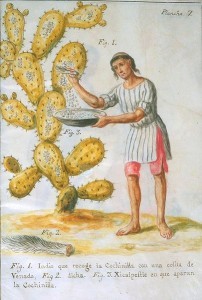Opuntia ficus-indica

When one hears the word “cactus,” the plant that most commonly comes to mind is Opuntia ficus-indica. The Opuntias are one of the most quintessential cacti, and O. ficus-indica is certainly the most common species seen. Opuntia ficus-indica holds this place of recognition due to its extreme economic value. Opuntia ficus-indica has been used for centuries as a source of food, and it is believed that Columbus returned to Lisbon with O. ficus-indica on board in 1493 after finding it under extensive cultivation.[1]
Opuntia ficus-indica, commonly called the prickly pear cactus, produces edible fruits as well as having pads. The fruits and pads are commonly seen food items in Mexico, the Caribbean, and the southwestern United States. In addition to providing a valuable food crop, O. ficus-indica is used in the production of the scale insect Dactylopius coccus, which is the source of the dye cochineal or carmine. The insect feeds upon O. ficus-indica, and once the colony has grown to sufficient size, the insects are collected and processed into dye. The production of cochineal in Mexico was an incredibly important business for many centuries and for much of Mexico’s history cochineal was the second most valuable export, behind silver.[2] The production of cochineal is still an important business, and it is still used as a food coloring and in cosmetics. The immense importance of O. ficus-indica in the production of food and dye can still be seen today, as O. ficus-indica is represented on the flag of Mexico.
[1] Griffith, M.P. (2004) The origins of an important cactus crop, Opuntia ficus-indica (Cactaceae): New molecular evidence. American Journal of Botany 91:1915-1921.
[2] Chavez-Moreno, C.K., Tecante, A. & Casas, A. (2009) The Opuntia (Cactaceae) and Dactylopius (Hemiptera:Dactylopiidae) in Mexico: a historical perspective of use, interaction and distribution. Biodiversity and Conservation 18:3337-3355.
